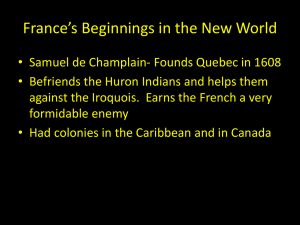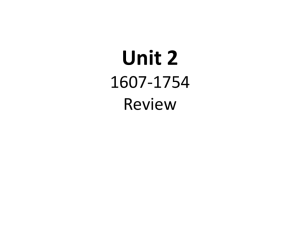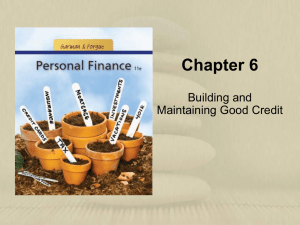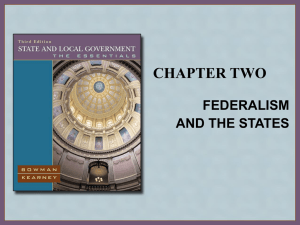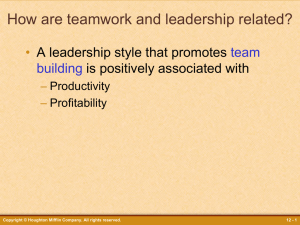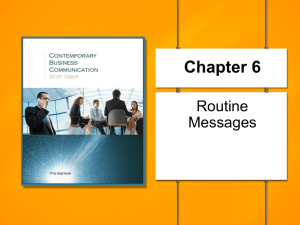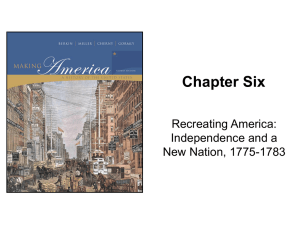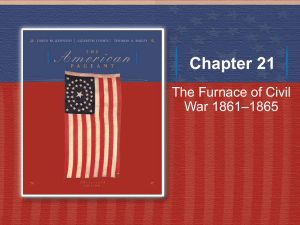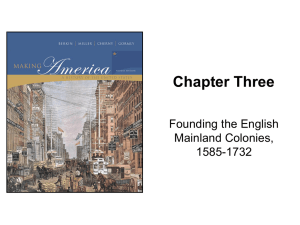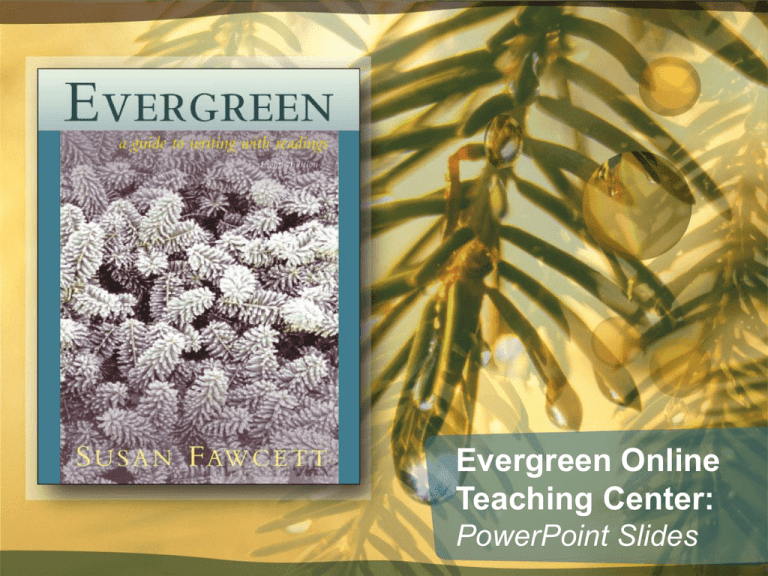
Evergreen Online
Teaching Center:
PowerPoint Slides
The Writing Process
PREWRITING
• Thinking about possible subjects
• Freely jotting ideas
• Narrowing the subject and writing your
main idea in one sentence
• Deciding which ideas to include
• Arranging ideas in a plan or outline
Copyright © Houghton Mifflin Company. All rights reserved.
Slide 2
The Writing Process (cont’d)
WRITING
• Writing the first draft
REVISING
• Rethinking, rearranging, revising
• Writing one or more new drafts
• Proofreading
Copyright © Houghton Mifflin Company. All rights reserved.
Slide 3
Subject, Audience, Purpose
Read these sentences from real job-application
letters and resumes. Specifically, how does each
writer undercut his or her purpose—to get
that job?
1. I have lurnt Word and computer spreadsheet programs.
2. Please don’t misconstrue my 14 jobs as “job-hopping.” I
have never quit a job.
3. I procrastinate, especially when the task is unpleasant.
Copyright © Houghton Mifflin Company. All rights reserved.
Slide 4
Subject, Audience, Purpose (cont’d)
4. Let’s meet, so you can “ooh” and “aah” over my
experience.
5. It is best for employers that I not work with people.
6. Reason for leaving my last job: maturity leave.
7. As indicted, I have over five years of analyzing
investments.
8. References: none. I have left a path of destruction
behind me.
Copyright © Houghton Mifflin Company. All rights reserved.
Slide 5
Five Prewriting Techniques
1.
2.
3.
4.
5.
Freewriting
Brainstorming
Clustering
Asking Questions
Keeping a journal
Copyright © Houghton Mifflin Company. All rights reserved.
Slide 6
The Reporter’s Six Questions
•
•
•
•
•
•
Who?
What?
Where?
When?
Why?
How?
Copyright © Houghton Mifflin Company. All rights reserved.
Slide 7
Ask Your Own Questions
As a class, discuss what you’d like to know
about one of these topics:
•
•
•
student stress
binge drinking
the death penalty
List questions about the topic that will lead
to the information you want.
Copyright © Houghton Mifflin Company. All rights reserved.
Slide 8
The Paragraph: Topic
Sentence and Body
The topic sentence states the main idea. The
body develops and supports this main idea.
Topic Sentence
Body:
a. Supporting Point 1
b. Supporting Point 2
c. Supporting Point 3
Conclusion
Copyright © Houghton Mifflin Company. All rights reserved.
Slide 9
Topic Sentence and Body
Find the topic sentence. Does the body fully support it?
I allow the spiders the run of the house. I figure that any predator
that hopes to make a living on whatever smaller creatures might
blunder into a four-inch-square bit of space in the corner of the
bathroom where the rub meets the floor needs every bit of my
support. They catch flies and even field crickets in those webs.
Large spiders in barns have been known to trap, wrap, and suck
hummingbirds, but there’s no danger of that here. I tolerate the
webs, only occasionally sweeping away the very dirtiest of them
after the spider itself has scrambled to safety. I’m always leaving
a bath towel draped over the tub so that the big, haired spiders,
who are constantly getting trapped by the tub’s smooth sides, can
use its rough surface as an exit ramp. Inside the house the
spiders have only given me one mild surprise. I washed some
dishes and set them to dry over a plastic drainer. Then I wanted a
cup of coffee, so I picked from the drainer my mug, which was still
warm from the hot rinse water, and across the rim of the mug,
strand after strand, was a spider web.
--Annie Dillard
Copyright © Houghton Mifflin Company. All rights reserved.
Slide 10
Finding and Underlining Topic
Sentences and Main Ideas
Identify the topic sentence.
The summer picnic gave ladies a chance to show off their
baking hands. On the barbecue pit, chickens and spareribs
sputtered in their own fat and in a sauce whose recipe was
guarded in the family like a scandalous affair. However,
every true baking artist could reveal her prize to the delight
and criticism of the town. Orange sponge cakes and dark
brown mounds dripping Hershey’s chocolate stood layer to
layer with ice-white coconuts and light brown caramels.
Pound cakes sagged with their buttery weight and small
children could no more resist licking the icings than their
mothers could avoid slapping the sticky fingers.
--Maya Angelou, I Know Why the Caged Bird Sings
Copyright © Houghton Mifflin Company. All rights reserved.
Slide 11
Finding and Underlining Topic
Sentences and Main Ideas
Identify the topic sentence.
These people often stay late at the office even if they are not
paid extra to do so. On weekends, they think about their
jobs—trying to solve a problem, worrying about a client, or
planning for Monday. If you ask them to explain, they will
probably tell you that they love working, that many aspects of
their job are fun. It doesn’t matter whether they are the
heads of companies or clerks at a local flower shop. What
matters is the match between their passion, interests,
personalities, and the work they do. A few lucky people have
found for themselves what many seek—the perfect job.
--Jared Barnes, Job Watch
Copyright © Houghton Mifflin Company. All rights reserved.
Slide 12
Steps for Writing
an Effective Paragraph
1.
2.
3.
4.
5.
6.
7.
8.
9.
Narrow the topic.
Write the topic sentence.
Brainstorm ideas for the body.
Select and drop ideas.
Group related ideas.
Write your first draft.
Reread and revise.
Neatly rewrite the final draft.
Proofread.
Copyright © Houghton Mifflin Company. All rights reserved.
Slide 13
Help! Topic Sentence Repair Needed
Evaluate and revise these topic sentences:
1. This paragraph will cover procrastination.
2. Exercise is an important topic.
3. Ways to lose weight.
Copyright © Houghton Mifflin Company. All rights reserved.
Slide 14
Revision Checklist
• Check your topic sentence. Revise if it’s
incomplete or unclear.
• Check for adequate support. Add facts and
details where needed.
• Check for unity. Drop words and
sentences that don’t support the main idea.
Copyright © Houghton Mifflin Company. All rights reserved.
Slide 15
Revising for Support
Check this paragraph for adequate support. Then
rewrite it, dropping repetitious words or sentences
and inventing facts and details if necessary.
(1) Lending money to a friend can have negative
consequences. (2) For example, Ashley, a
student at Tornado Community College, agreed to
lend $200 to her best friend, Jan. (3) This was a
bad decision even though Ashley meant well. (4)
The results of this loan were surprising and
negative for Ashley, for Jan, and for the friendship.
(5) both women felt bad about it but in different
ways. (6) Yes, lending money to a friend can
have very negative consequences, like anger and
hurt.
Copyright © Houghton Mifflin Company. All rights reserved.
Slide 16
Peer Feedback Sheet
To____________________From_______________________Date__________
1. What I like about this piece of writing is ___________________________.
2. Your main point seems to be _____________________________________.
3. These particular words or lines struck me as powerful:
Words or lines
I like them because
_____________________________
_____________________________
_____________________________
_____________________________
4. Some things aren’t clear to me. These lines or parts could be improved
(meaning not clear, supporting points missing, order seems mixed up,
writing not lively):
Lines or parts
Need improving because
______________________________ ______________________________
______________________________ ______________________________
5. The one change you could make that would make the biggest improvement in
this piece of writing is ______________________________________.
Copyright © Houghton Mifflin Company. All rights reserved.
Slide 17
Checklist: The Process of
Writing Basic Paragraphs
1. Narrow the topic.
2. Write a clear topic sentence
3. Freewrite or brainstorm, generating facts, details,
and examples.
4. Select ideas for the body of the paragraph.
5. Arrange ideas in a plan or an outline.
6. Write the best first draft you can.
7. Conclude. Don’t just leave the paragraph hanging.
8. Revise as necessary, checking your paragraph for
support and unity.
9. Proofread for errors.
Copyright © Houghton Mifflin Company. All rights reserved.
Slide 18
Coherence Through Order
TIME ORDER
• Also known as chronological order
• Suited to stories, histories, instructions
• Includes key words like first, then, next, etc.
• Topic sentence can be implied
SPACE ORDER
• Used in descriptions of people, places, things
• Top to bottom, left to right, front to back, etc.
• Includes key words like near, around, on, etc.
• Topic sentence can be implied
ORDER OF IMPORTANCE
• Most to least important (or vice versa), smallest to largest (or
vice versa), etc.
• Includes key words like more and most
Copyright © Houghton Mifflin Company. All rights reserved.
Slide 19
Coherence Through Time Order
(1) In 1905, a poor washerwoman with a homemade hair product
started a business—with $1.50! (2) In just five years, Madam
C.J. Walker established offices and manufacturing centers in
Denver, Pittsburgh, and Indianapolis. (3) The Madame C.J.
Walker Manufacturing Company specialized in hair supplies, but
Madame Walker specialized in independence for herself and
others. (4) Although she was not formally educated, she
developed an international sales force, teaching her AfricanAmerican agents the most sophisticated business skills. (5)
Eight years after starting her business, Madame Walker was the
first African-American woman to become a self-made millionaire.
(6) In addition, she drew thousands of former farm and domestic
workers into the business world. (7) One of her most original
ideas was to establish “Walker Clubs,” and she awarded cash
prizes to the clubs with the most educational and philanthropic
projects in their African-American communities. (8) When she
died in 1919, Madame Walker left two-thirds of her fortune to
schools and charities. (9) Another of her contributions also lived
on. (10) After her death, many of her former employees used
their experience to start businesses throughout the United States
and the Caribbean.
Copyright © Houghton Mifflin Company. All rights reserved.
Slide 20
Coherence Through Space Order
(1) Just inside the door of Filene’s Basement, Boston’s famous
bargain clothing store, giant hanging signs explain that the longer
an item remains in the store, the cheaper it becomes. (2) All
around the walls, floor-to-ceiling racks are crammed with a random
mix of shoes, sneakers, neckties, and handbags. (3) Counters are
cluttered with rhinestone rings, plastic sunglasses, and silk scarves.
(4) In the center of the floor, huge square bins contain disorganized
piles of shoes and clothes. (5) Customers dig into these jumbled
bins, pulling out yellow rain hats, pink suede pumps, even cheese
graters and other items that belong in a kitchen department. (6)
Friends lose each other in the crowded aisles. (7) Frantic shoppers
often collide as items fly into the air. (8) some customers question
whether any bargain makes this chaos worthwhile, but they always
seem to return.
--Emma Lou Haynes (student)
Copyright © Houghton Mifflin Company. All rights reserved.
Slide 21
Coherence Through
Order of Importance
(1) Louis Pasteur is revered as a great scientist for his three major
discoveries. (2) Most important, this Frenchman created vaccines
that have saved millions of human and animal lives. (3) The
vaccines grew out of his discovery that weakened forms of a
disease could help the person or animal build up antibodies that
would prevent the disease. (4) The vaccines used today to protect
children from serious illnesses owe their existence to Pasteur’s
word. (5) Almost as important was Pasteur’s brilliant idea that tiny
living beings, not chemical reactions, spoiled beverages. (6) He
developed a process, pasteurization, that keeps milk, wine, vinegar,
and beer from spoiling. (7) Finally, Pasteur found ways to stop a
silkworm disease that threatened to ruin France’s profitable silk
industry. (8) Many medical researchers regard him as the “the
father of modern medicine.”
Copyright © Houghton Mifflin Company. All rights reserved.
Slide 22
Coherence Through Related Sentences
•
•
•
•
REPEAT important words and pronouns.
USE synonyms.
SUBSTITUTE pronouns.
USE transitional expressions.
Copyright © Houghton Mifflin Company. All rights reserved.
Slide 23
Transitional Expressions at a Glance 1
Purpose
To add
Transitional Expressions
also, and, and then, as well besides,
beyond that, first (second, third, last,
and so on), for one thing, furthermore,
in addition, moreover, next, what is
more
To compare
also, as well, both (neither), in the
same way, likewise, similarly
Copyright © Houghton Mifflin Company. All rights reserved.
Slide 24
Transitional Expressions at a Glance 2
Purpose
To contrast
Transitional Expressions
although, be that as it however, in
contrast, nevertheless, on the contrary,
on the other hand whereas, yet
To concede
certainly, granted that, (a point)of
course, no doubt, to be sure
Copyright © Houghton Mifflin Company. All rights reserved.
Slide 25
Transitional Expressions at a Glance 3
Purpose
Transitional Expressions
To emphasize above all, especially, indeed, in fact, in
particular, most important, surely
To illustrate
as a case in point, as an illustration, for
example, for instance, in particular one
such, yet another
Copyright © Houghton Mifflin Company. All rights reserved.
Slide 26
Transitional Expressions at a Glance 4
Purpose
To place
Transitional Expressions
above, below, beside, beyond farther,
here, inside, nearby, next to, on the far
side, opposite, outside, to the east
(south, and so on)
To qualify
perhaps, maybe
To give a
as, because, for, since
reason/cause
Copyright © Houghton Mifflin Company. All rights reserved.
Slide 27
Transitional Expressions at a Glance 5
Purpose
To show
Transitional Expressions
and so, as a consequence, as a
result/effect result, because of this,
consequently, for this reason, hence,
so, therefore, thus
To
summarize
all in all, finally, in brief, in other words,
lastly, on the whole, to sum up
To place
in time
after a while, afterward,at last, at
present, briefly, currently, during,
eventually
Copyright © Houghton Mifflin Company. All rights reserved.
Slide 28
Adding Transitional Expressions
What transitional expressions will best guide the reader?
Great athletes do not reach the top by talent alone but by pushing
themselves to the limit and beyond. ________, golf legend Tiger Woods
keeps striving for perfection. Long after dark--even during tournaments--he
practices at the driving range, hitting ball after ball. Even after winning his
first Masters Tournament in 1997, Tiger spent 18 months refining his swing.
________, he added twenty pounds of muscle to his lean frame with a
secret training plan. ________ example is hard-working tennis star Serena
Williams, who practices on the court for hours each day with her sister
Venus. Serena builds her speed and strength with yoga, running, weightlifting, and boxing. By studying videotapes of all her matches, she
constantly improves her game. Perhaps no player in any sport, _____, can
match the work ethic of Lance Armstrong. ________, this bicycle racer was
diagnosed with testicular cancer that had spread to his brain and lungs.
________ surgery and chemotherapy left him weak and exhausted,
Armstrong began a brutal training regiment, following a strict diet and cycling
up to six hours a day. His commitment paid off, when in 1999 and every
year through 2002, he won the Tour de France, cycling’s toughest race.
________ many top athletes, he turned his talent into greatness through
sheer hard work.
(See page 68 of Evergreen for possible answers.)
Copyright © Houghton Mifflin Company. All rights reserved.
Slide 29
Young Immigrant Translators
When immigrant children become translators for their parents,
this can change the normal relationship between parent and child.
Many immigrant parents do not have the time or opportunity to
develop their English skills, even though they know that speaking
English is the most important part of surviving in the United States.
When they need to understand or speak English, they often ask
their school-age children for help. The children must act like little
adults, helping their parents with all kinds of problems. They end up
taking time away from school and their friends because they are
responsible for everything related to English. For example, they
might have to answer the phone, fill out forms, pay bills, or shop for
groceries. Even in more serious situations, like medical or financial
problems, the children might have to translate for the doctor or
accountant. Eventually, some children can start to resent their
parents for relying on them so much. Instead of turning to their
parents for help with their homework or personal worries, they might
turn instead to friends or teachers who understand the culture
better. Although most immigrant children know their parents love
them and want a better life for them, the role reversal of being child
translators can make them become adults too soon.
--Mandy Li (student)
Copyright © Houghton Mifflin Company. All rights reserved.
Slide 30
The Illustration Paragraph
To illustrate is to explain a general
statement by means of one or more
specific examples.
Copyright © Houghton Mifflin Company. All rights reserved.
Slide 31
Illustration Paragraph
Great athletes do not reach the top by talent alone but by pushing
themselves to the limit and beyond. For instance, golf legend Tiger
Woods keeps striving for perfection. Long after dark—even during
tournaments—he practices at the driving range, hitting ball after
ball. Even after winning his first Master’s tournament in 1997, Tiger
spent 18 months refining his swing. Recently, he added twenty
pounds of muscle to his lean frame with a secret training plan.
Another example is hard-working tennis star Serena Williams, who
practices on the court for hours each day with her sister Venus.
Serena builds her speed and strength with yoga, running, weightlifting, and boxing. By studying videotapes of all her matches, she
constantly improves her game. Perhaps no player in any sport,
however, can match the work ethic of Lance Armstrong. In 1996,
this bicycle racer was diagnosed with testicular cancer that had
spread to his brain and lungs. After surgery and chemotherapy left
him weak and exhausted, Armstrong began a strict training
regimen, following a strict diet and cycling up to six hours a day.
His commitment paid off when, in 1999 and again in 2002, he won
the Tour de France, cycling’s toughest race. Like many top
athletes, he turned his talent into greatness through sheer hard
work.
Copyright © Houghton Mifflin Company. All rights reserved.
Slide 32
Transitional Expressions
for Illustration
for instance
another instance of
for example
another example of
an illustration another illustration of
of this
a case in point is
here are a few examples
to illustrate
Copyright © Houghton Mifflin Company. All rights reserved.
Slide 33
The Process of Writing
an Illustration Paragraph
1. Narrow the topic.
2. Compose a topic sentence that can be supported
by examples.
3. Freewrite or brainstorm to find examples.
4. Select only the best two to four examples.
5. Make a plan or an outline.
6. Write a draft of your paragraph, using transitional
expressions.
7. Revise as necessary.
8. Proofread for errors.
Copyright © Houghton Mifflin Company. All rights reserved.
Slide 34
The Narrative Paragraph
To narrate is to tell a story that explains
what happened, when it happened, and
who was involved.
Copyright © Houghton Mifflin Company. All rights reserved.
Slide 35
Transitional Expressions for Narratives
after
as (soon as)
before
during
first
finally
later
meanwhile
next
now
Copyright © Houghton Mifflin Company. All rights reserved.
soon
then
upon
when
while
Slide 36
The Process of Writing
a Narrative Paragraph
1. Narrow the topic.
2. Compose a topic sentence that tells the point of
the story.
3. Freewrite or brainstorm for all of the events and
details.
4. Select the important events and details.
5. Make a plan or an outline.
6. Write a draft of your paragraph.
7. Revise as necessary.
8. Proofread for errors.
Copyright © Houghton Mifflin Company. All rights reserved.
Slide 37
The Descriptive Paragraph
To describe something—a person, a place,
or an object—is to capture it in words so
others can imagine it or see it in their
mind’s eye.
Copyright © Houghton Mifflin Company. All rights reserved.
Slide 38
Transitional Expressions
Indicating Place
next to, near
on top, beneath
close, far
toward, away
up, down, between
left, right, center
above, below
front, back, middle
Copyright © Houghton Mifflin Company. All rights reserved.
Slide 39
The Process of Writing
a Descriptive Paragraph
1. Narrow the topic.
2. Compose a topic sentence that points to what you
will describe or gives an overall impression.
3. Freewrite or brainstorm to find specific details.
4. Select the best details.
5. Make a plan or an outline.
6. Write a draft of your paragraph.
7. Revise as necessary.
8. Proofread for errors.
Copyright © Houghton Mifflin Company. All rights reserved.
Slide 40
Two Kinds of Process Paragraphs
HOW-TO PARAGRAPH
The how-to paragraph gives the reader directions
on how he or she can do something: how to install
a software program, how to get to the airport, or
how to make barbecued ribs.
EXPLANATION PARAGRAPH
The explanation paragraph tells the reader how a
particular event occurred or how something works.
Copyright © Houghton Mifflin Company. All rights reserved.
Slide 41
Transitional Expressions for Process
BEGINNING A PROCESS
(at first), initially, begin by
CONTINUING A PROCESS
second (third) step, until, after(ward), then, next, later,
before, when, while, as soon as, as, upon, during,
meanwhile
ENDING A PROCESS
finally, at last
Copyright © Houghton Mifflin Company. All rights reserved.
Slide 42
The Process of Writing
a Process Paragraph
1. Narrow the topic.
2. Compose a topic sentence that states the goals or
end result of the process.
3. Freewrite or brainstorm to generate steps of the
process.
4. Drop any irrelevant information.
5. Make an outline or a plan for your paragraph.
6. Write a draft of your paragraph.
7. Revise as necessary.
8. Proofread for errors.
Copyright © Houghton Mifflin Company. All rights reserved.
Slide 43
The Definition Paragraph
To define is to explain clearly what a word
or term means.
Copyright © Houghton Mifflin Company. All rights reserved.
Slide 44
Three Ways to
Define a Word or Term
1. Definition by synonym. Supply a word
that means the same thing.
2. Definition by class. Place the word in the
category to which it belongs and provide
distinguishing characteristics.
3. Definition by negation. Tell what the
word is not, then tell what it is.
Copyright © Houghton Mifflin Company. All rights reserved.
Slide 45
The Process of Writing
a Definition Paragraph
1. Narrow the topic.
2. Compose a topic sentence that uses synonym,
class, or negation.
3. Decide on the best method of development.
4. Freewrite or brainstorm to generate ideas.
5. Select the best ideas.
6. Make a plan or an outline.
7. Write a draft of your paragraph.
8. Revise as necessary.
9. Proofread for errors.
Copyright © Houghton Mifflin Company. All rights reserved.
Slide 46
Comparison and Contrast Paragraphs
To contrast two persons, places, or things
is to examine the ways in which they are
different.
To compare them is to examine the ways in
which they are similar.
Copyright © Houghton Mifflin Company. All rights reserved.
Slide 47
Transitional Expressions for Contrast
although
whereas
but
however
conversely
on the other hand
in contrast
while
yet
unlike
Copyright © Houghton Mifflin Company. All rights reserved.
Slide 48
Transitional Expressions
for Comparison
in the same way
and, also, in addition
as well as
both, neither
each of
Copyright © Houghton Mifflin Company. All rights reserved.
just as…so
similarly
like
too
the same
Slide 49
The Process of Writing a Contrast
or Comparison Paragraph
1. Narrow the topic.
2. Compose a topic sentence that clearly states that
a contrast or a comparison will follow.
3. Freewrite or brainstorm to generate points of
comparison or contrast.
4. Choose the points you will use.
5. List parallel points of contrast or of comparison for
both A and B.
6. Make a plan or an outline.
7. Write a draft of your paragraph.
8. Revise as necessary.
9. Proofread for errors.
Copyright © Houghton Mifflin Company. All rights reserved.
Slide 50
The Classification Paragraph
To classify is to gather into types, kinds, or
categories according to a single basis of
division.
Copyright © Houghton Mifflin Company. All rights reserved.
Slide 51
Transitional Expressions for
Classification
can be divided
can be classified
can be categorized
Copyright © Houghton Mifflin Company. All rights reserved.
the first type
the second kind
the last category
Slide 52
The Process of Writing
a Classification Paragraph
1. Narrow the topic.
2. Decide on a single basis of classification.
3. Compose a topic sentence that clearly shows what
you are dividing into categories or types.
4. List the categories into which the group is being
classified.
5. Freewrite, cluster, or brainstorm to generate
information, details, and examples.
6. Select the best details and examples.
7. Make a plan or an outline.
8. Write a draft of your paragraph.
9. Revise as necessary.
10. Proofread for errors.
Copyright © Houghton Mifflin Company. All rights reserved.
Slide 53
The Cause and Effect Paragraph
Causes are the reasons for events.
Effects are the results of a cause or causes.
Copyright © Houghton Mifflin Company. All rights reserved.
Slide 54
Transitional Expressions
for Cause and Effect
To Show Causes
the first cause
(second, third)
the first reason
(second, third)
yet another factor
because
is caused by
results from
Copyright © Houghton Mifflin Company. All rights reserved.
To Show Effects
one important effect
another result
a third outcome
as a result
consequently
then, next, therefore,
thus, so
Slide 55
The Process of Writing a Cause and
Effect Paragraph
1. Narrow the topic.
2. Decide whether you will emphasize causes or
effects.
3. Compose a topic sentence that states the subject
and indicates whether causes or effects will be
discussed.
4. Now freewrite, brainstorm, or cluster to find at least
three possible causes or effects.
5. Select the best causes and effects.
6. Make a plan or outline.
7. Write a first draft of your paragraph.
8. Revise as necessary.
9. Proofread for errors.
Copyright © Houghton Mifflin Company. All rights reserved.
Slide 56
The Persuasive Paragraph
To persuade is to convince someone that a
particular opinion or point of view is the
correct one.
Copyright © Houghton Mifflin Company. All rights reserved.
Slide 57
Transitional Expressions for
Persuasion
Give Reasons
first (second, third), another, next, last, finally,
because, since, for
Answer the Opposition
of course, some may say, nevertheless, on the
other hand
Draw Conclusions
therefore, thus, hence, consequently
Copyright © Houghton Mifflin Company. All rights reserved.
Slide 58
Methods of Persuasion
1.
2.
3.
4.
5.
Facts
Referring to an authority
Examples
Predicting the consequence
Answering the opposition
Copyright © Houghton Mifflin Company. All rights reserved.
Slide 59
Avoiding Flawed Reasoning 1
Which reason seems irrelevant, illogical, or untrue?
1. If you wanted to persuade someone to do holiday
shopping earlier, you might say that
a. Shopping earlier saves time.
b. More gifts will be in stock.
c. Stores will not be overly crowded.
d. Nora Jones shops early.
2. If you wanted to persuade someone to buy a
particular brand of cereal, you might say that
a. It is inexpensive.
b. It contains vitamins and minerals.
c. It comes in an attractive box.
d. It makes a hearty breakfast.
Copyright © Houghton Mifflin Company. All rights reserved.
Slide 60
Avoiding Flawed Reasoning 2
3. If you wanted to persuade someone to move to
your town, you might say that
a. Two new companies have made jobs available.
b. By moving to this town, he or she will become the
happiest person in the world.
c. There is a wide selection of housing.
d. The area is lovely and still unpolluted.
4. If you wanted to persuade someone to vote for a
particular candidate, you might say that
a.
b.
c.
d.
She has always kept her promises to the voters.
She has lived in the district for thirty years.
She has substantial knowledge of the issues.
She dresses very fashionably.
Copyright © Houghton Mifflin Company. All rights reserved.
Slide 61
Avoiding Flawed Reasoning 3
5. If you wanted to persuade someone to learn to read and
speak a foreign language, you might say that
a. Knowledge of a foreign language can be helpful in the
business world.
b. He or she may want to travel in the country where the
language is spoken.
c. Enrique Iglesias sings in two languages.
d. Being able to read great literature in the original is a
rewarding experience.
6. If you wanted to persuade someone to quit smoking, you
might say that
a. Smoking is a major cause of lung cancer.
b. Smoking stains teeth and softens gums.
c. Ashtrays are often hard to find.
d. This bad habit has become increasingly expensive.
Copyright © Houghton Mifflin Company. All rights reserved.
Slide 62
The Process of Writing
a Persuasive Paragraph
1. Narrow the topic.
2. Compose a topic sentence that clearly states your position
for or against.
3. Freewrite or brainstorm to generate reasons.
4. Select the best three or four reasons.
5. Be sure that your facts are accurate, examples are valid,
references to authorities are not biased, predictions about
consequences are logical, and the opposition’s arguments
are stated fairly and adequately refuted.
6. Make a plan or outline.
7. Write a draft of your paragraph.
8. Revise as necessary.
9. Proofread for errors.
Copyright © Houghton Mifflin Company. All rights reserved.
Slide 63
Which Paragraph Type?
Choose one method of development by which you
might turn each topic sentence into a good
paragraph.
1. My kitchen is a mess of dirty dishes.
2. The minimum age for a driver’s license should be raised
to 18.
3. In-ground and above-ground pools are alike in several
respects.
4. There are five key steps in planting a tree correctly.
5. Increasing our use of alternative energies will help
reverse environmental damage.
Copyright © Houghton Mifflin Company. All rights reserved.
Slide 64
Parts of an Essay
INTRODUCTORY PARAGRAPH
aims to catch the reader’s interest
usually contains a thesis statement
BODY
consists of one, two, three, or more paragraphs,
each one making a different point about the main
idea.
CONCLUSION
brings the essay to a close
might be a sentence or a paragraph long
Copyright © Houghton Mifflin Company. All rights reserved.
Slide 65
The Paragraph and the Essay
The Essay
Introduction
Thesis Statement
The Paragraph
Topic Sentence
Body of
supporting
statements
Concluding sentence
Body of
supporting
paragraphs
Conclusion
Copyright © Houghton Mifflin Company. All rights reserved.
Slide 66
Four Ways to Link
Paragraphs in Essays
1. REPEAT key words or ideas from thesis
statement.
2. REFER to words or ideas from preceding
paragraph.
3. USE transitional expressions.
4. USE transitional sentences.
Copyright © Houghton Mifflin Company. All rights reserved.
Slide 67
Questions to Ask As You Revise
1. Is my thesis statement clear?
2. Does the body of the essay fully support
my thesis statement?
3. Does the essay have unity; does every
paragraph relate to the thesis statement?
4. Does the essay have coherence; do the
paragraphs follow a logical order?
Copyright © Houghton Mifflin Company. All rights reserved.
Slide 68
Questions to Ask As You Revise (CONT’D)
5. Are my topic sentences clear?
6. Does each paragraph provide good details,
well-chosen examples, and so on?
7. Is the language exact, concise, and fresh?
8. Are my sentences varied in length and
type?
9. Does the essay conclude, not just leave
off?
Copyright © Houghton Mifflin Company. All rights reserved.
Slide 69
Peer Reviewer Questions
1. What do you like about this piece of
writing?
2. What seems to be the main point?
3. Which parts could be improved (for
example, unclear sentences, supporting
points missing, order mixed up, writing not
lively, and so forth)? Be specific.
4. What one change would most improve this
essay?
Copyright © Houghton Mifflin Company. All rights reserved.
Slide 70
The Process of Writing an Essay
1. Narrow the topic.
2. Write a clear thesis statement.
3. Freewrite or brainstorm, generating facts, details,
and examples.
4. Plan or outline your essay.
5. Write a topic sentence for each main idea.
6. Decide on a logical order in which to present the
paragraphs.
7. Plan the body of each paragraph.
8. Write the first draft of your essay.
9. Revise as necessary.
10. Proofread carefully for errors.
Copyright © Houghton Mifflin Company. All rights reserved.
Slide 71
Nine Types of Essays
1.
2.
3.
4.
5.
6.
7.
8.
9.
The Illustration Essay
The Narrative Essay
The Descriptive Essay
The Process Essay
The Definition Essay
The Comparison or Contrast Essay
The Classification Essay
The Cause and Effect Essay
The Persuasive Essay
Copyright © Houghton Mifflin Company. All rights reserved.
Slide 72
Two Functions of the Introduction
1. It sets forth the essay’s central idea and
usually contains the thesis statement.
2. It catches the reader’s interest so that he or
she will keep reading.
Copyright © Houghton Mifflin Company. All rights reserved.
Slide 73
Six Effective Introductions
1. Begin with a single-sentence thesis
statement.
2. Begin with a general idea and then narrow
to a specific thesis statement.
3. Begin with an illustration.
4. Begin with a surprising fact or idea.
5. Begin with a contradiction.
6. Begin with a direct quotation.
Copyright © Houghton Mifflin Company. All rights reserved.
Slide 74
Three Ways to Conclude an Essay
1. End with a call to action.
2. End with a final point.
3. End with a question.
Copyright © Houghton Mifflin Company. All rights reserved.
Slide 75
Four Kinds of Titles
1.
2.
3.
4.
No-nonsense descriptive title
Two-part title
Rhetorical question
Title related to method of development
used in essay
Copyright © Houghton Mifflin Company. All rights reserved.
Slide 76
What Is Plagiarism?
Plagiarism is failing to give proper credit to
an author whose words or ideas you have
used. That is, plagiarism means passing
off someone else’s words or ideas as your
own. Whether intentional or careless,
plagiarism is stealing.
Copyright © Houghton Mifflin Company. All rights reserved.
Slide 77
Features of a Summary
Your summary should include:
1. The author, title, and source of the original.
2. The main idea or thesis of the original, in
your own words.
3. The most important supporting ideas or
points of the original, in your own words.
4. A summary should not include the
summarizer’s thoughts or feelings.
Copyright © Houghton Mifflin Company. All rights reserved.
Slide 78
The Process of Writing a Summary
1. Read the title and subtitle of the original; do they
state its main idea?
2. Read the original quickly for meaning; then
carefully read it again.
3. Determine the author’s main idea.
4. Now find the main supporting points.
5. Write your topic sentence or thesis statement.
6. In your own words, give the author’s most
important supporting points.
7. Write your summary.
8. Now revise.
9. Proofread.
10. Compare your final draft with the original to avoid
plagiarism.
Copyright © Houghton Mifflin Company. All rights reserved.
Slide 79
Ways to Introduce Quotations
Mr. Taibi says…
One expert had this to say:
In a recent Times column,
Maureen Dowd observes…
Ms. Luboff writes,…
…, one authority reported.
According to Dr. Haynes,…
Copyright © Houghton Mifflin Company. All rights reserved.
Slide 80
Library Resources for Research
1.
2.
3.
4.
Online Catalog or Card Catalog
Periodical Indexes
Statistical Sources
Encyclopedias and Reference Books
Copyright © Houghton Mifflin Company. All rights reserved.
Slide 81
Internet Sources: Watch Out!
Carefully evaluate all web sources.
1. Who sponsors the site?
2. How balanced and fair is the information?
3. Did an expert write the article?
4. When was the article written?
5. When was the site updated?
Copyright © Houghton Mifflin Company. All rights reserved.
Slide 82
MLA Style
A correct citation:
• tells reader that the material is from an
outside source.
• gives reader enough information to find the
original source.
• appears in two places: inside the essay in
parentheses and at the end in a Works
Cited list
Copyright © Houghton Mifflin Company. All rights reserved.
Slide 83
Test-Taking Tips
• With classmates, discuss test-taking
strategies that have worked for you in the
past. What methods do you use to budget
your exam time wisely? What advice would
you give someone with test anxiety?
• Compare your ideas to the tips in
Evergreen, pages 253-254.
Copyright © Houghton Mifflin Company. All rights reserved.
Slide 84
Instruction Words
Used in College Examinations
1.
2.
3.
4.
5.
6.
7.
Classify
Compare
Contrast
Define
Discuss (analyze, describe, explain)
Discuss causes
Discuss effects
Copyright © Houghton Mifflin Company. All rights reserved.
Slide 85
Instruction Words
Used in College Examinations (CONT’D)
8. Evaluate
9. Identify
10. Illustrate
11. Narrate (trace)
12. Summarize
13. Take a stand
Copyright © Houghton Mifflin Company. All rights reserved.
Slide 86
The Process of Answering
an Essay Question
1.
2.
3.
4.
5.
6.
7.
8.
Survey the test.
Calculate how much time you need.
Read each question carefully.
Determine how many parts the answer should
contain.
Choose the paragraph or essay pattern that would
best answer the question.
Write a topic sentence or a thesis statement that
repeats the key words of the question.
Quickly freewrite or brainstorm ideas and make a
scratch outline or plan.
Write your paragraph or essay neatly, skipping
lines.
Copyright © Houghton Mifflin Company. All rights reserved.
Slide 87
Nine Great Ways
to Vary Your Sentences
1. Mix long and short sentences.
2. Add an occasional question, command, or
exclamation.
3. Begin with an adverb.
4. Begin with a prepositional phrase.
5. Join ideas with a compound predicate.
6. Join ideas with an –ing modifier.
7. Join ideas with a past participial modifier.
8. Join ideas with an appositive.
9. Join ideas with a relative clause.
Copyright © Houghton Mifflin Company. All rights reserved.
Slide 88
Correcting Confusing Modifiers
Correct these sentences by making confusing
modifiers clear.
1. Leaping from tree to tree, the professor spotted a
monkey.
2. Brenda saw a large moose driving her car down
State Street.
3. Lying in the garbage, Teresa found the book.
4. My boss spotted our delivery truck eating lunch
downtown.
5. Chewing wires under the desk, Mr. Nelson saw a
small mouse.
Copyright © Houghton Mifflin Company. All rights reserved.
Slide 89
Answer Key:
Correcting Confusing Modifiers
1. The professor spotted a monkey leaping
from tree to tree.
2. Driving her car down State Street, Brenda
saw a large moose.
3. Teresa found the book lying in the garbage.
4. Eating lunch downtown, my boss spotted
our delivery truck.
5. Mr. Nelson saw a small mouse chewing
wires under the desk.
Copyright © Houghton Mifflin Company. All rights reserved.
Slide 90
Trite Expressions
and Cliches
at this point in time
awesome
better late than never
beak the ice
cold cruel world
cool, hot
cry your eyes out
easier said than done
free as a bird
hustle and bustle
Copyright © Houghton Mifflin Company. All rights reserved.
in this day and age
last but not least
living hand to mouth
one in a million
out of this world
sad but true
tried and true
under the weather
work like a dog
green with envy
Slide 91
Coordinating Conjunctions
and
for
or
but
nor
so
Copyright © Houghton Mifflin Company. All rights reserved.
yet
Slide 92
Subordinating Conjunctions
after
because
since
when(ever)
although
before
unless
whereas
as (if)
if
until
while
Copyright © Houghton Mifflin Company. All rights reserved.
Slide 93
Conjunctive Adverbs
consequently
furthermore
however
in fact
indeed
moreover
nevertheless
then
therefore
Copyright © Houghton Mifflin Company. All rights reserved.
Slide 94
Run-ons and Comma Splices
•
A run-on sentence incorrectly runs together
two independent clauses without a conjunction
or punctuation:
My neighbor Mr. Hoffman is seventy-five years old
he plays tennis every Saturday afternoon.
•
A comma splice incorrectly joins two
independent clauses with a comma but no
conjunction:
My neighbor Mr. Hoffman is seventy-five years old,
he plays tennis every Saturday afternoon.
Copyright © Houghton Mifflin Company. All rights reserved.
Slide 95
Five Ways to Correct a
Run-on or Comma Splice
1. Use two separate sentences:
My neighbor Mr. Hoffman is seventy-five years old.
He plays tennis every Saturday afternoon.
2. Use a coordinating conjunction:
My neighbor Mr. Hoffman is seventy-five years old,
but he plays tennis every Saturday afternoon.
3. Use a subordinating conjunction:
Although my neighbor Mr. Hoffman is seventy-five
years old, he plays tennis every Saturday
afternoon.
Copyright © Houghton
Mifflin Company. All rights reserved.
Slide 96
Five Ways to Correct a
Run-on or Comma Splice (CONT’D)
4. Use a semicolon:
My neighbor Mr. Hoffman is seventy-five years
old; he plays tennis every Saturday afternoon.
5. Use a semicolon and a conjunctive adverb:
My neighbor Mr. Hoffman is seventy-five years
old; however, he plays tennis every Saturday
afternoon.
Copyright © Houghton Mifflin Company. All rights reserved.
Slide 97
Six Types of Sentence Fragments
1.
2.
3.
4.
5.
6.
Dependent clause fragment
Relative clause fragment
-ing fragment
Prepositional phrase fragment
Appositive phrase fragment
Infinitive phrase fragment
Copyright © Houghton Mifflin Company. All rights reserved.
Slide 98
Review Chart:
Correcting Sentence Fragments 1
F=Fragment
C=Corrected
1. Dependent clause fragment
F: After Jake moved to Colorado.
C: After Jake moved to Colorado,
he learned to ski.
2. Relative clause fragment
F: Who loves computer games.
C: My niece, who loves computer games,
repairs my computer.
Copyright © Houghton Mifflin Company. All rights reserved.
Slide 99
Review Chart:
Correcting Sentence Fragments 2
F=Fragment
C=Corrected
3. -ing modifier fragment
F: Surfing the web.
C: Surfing the web, we visited European
art museum sites.
4. Prepositional phrase fragment
F: Inside the cave.
C: They found mastodon bones inside
the cave.
Copyright © Houghton Mifflin Company. All rights reserved.
Slide 100
Review Chart:
Correcting Sentence Fragments 3
F=Fragment
C=Corrected
5. Appositive fragment
F: A slow student.
C: Einstein, a slow student, proved to be a
genius.
6. Infinitive phrase fragment
F: To go dancing tonight.
C: She wants to go dancing tonight.
Copyright © Houghton Mifflin Company. All rights reserved.
Slide 101
Subject-Verb Agreement
Don’t let the
s
The light flicker
mislead you:
s.
(singular subject, singular verb)
The light
s flicker.
(plural subject, plural verb)
Copyright © Houghton Mifflin Company. All rights reserved.
Slide 102
Tricky Subject-Verb Agreement
•
•
•
•
•
Special singular constructions: Each of the
brothers loves soccer.
Separation of subject and verb: The economist’s
ideas on this matter surprise me.
Sentences beginning with There or Here: There
seem to be two flies in my soup.
Questions: Where are your copies of the annual
report?
Relative clauses: People who have a good sense
of humor make good neighbors.
Copyright © Houghton Mifflin Company. All rights reserved.
Slide 103
Making Nouns Plural
Change each subject and verb from singular to plural:
• The window looks dusty.
• The orchid needs water.
• The flat-screen television costs too much.
Change each subject and verb from plural to singular:
• The students graduate in May.
• My relatives live in Texas.
• The children juggle coconuts.
Copyright © Houghton Mifflin Company. All rights reserved.
Slide 104
Answer Key:
Making Nouns Plural
• The windows look dusty.
• The orchids need water.
• The flat-screen televisions cost too much.
• The student graduates in May.
• My relative lives in Texas.
• The child juggles coconuts.
Copyright © Houghton Mifflin Company. All rights reserved.
Slide 105
Nouns that Do Not Change from
Singular to Plural
Singular
Plural
deer
equipment
fish
merchandise
deer
equipment
fish
merchandise
Copyright © Houghton Mifflin Company. All rights reserved.
Slide 106
Forming Hyphenated Noun Plurals
Singular
Plural
brother-in-law
maid-of-honor
passer-by
brothers-in-law
maids-of-honor
passers-by
Copyright © Houghton Mifflin Company. All rights reserved.
Slide 107
Making Pronouns
and Antecedents Agree
Choose the correct pronoun.
1. Everyone should bring (their, his or her) laptop to class.
2. Can you go with George and (I, me) to the film festival?
3. The French club has elected (its, their) president.
4. To (who, whom) should I send this check?
5. Tiffany gave concert tickets to my girlfriend and (I, me).
6. Each of the women has bleached (her, their) hair blonde.
7. The van followed Jake and (he, him) at a distance .
8. She has more tattoos than (they, them).
9. My sister and (I, myself) plan to open a restaurant.
10. The mall shopper should throw (their, his or her) trash in the
trash can.
Copyright © Houghton Mifflin Company. All rights reserved.
Slide 108
Answer Key: Making Pronouns and
Antecedents Agree
1. Everyone should bring his or her laptop to class.
2. Can you go with George and me to the film
festival?
3. The French club has elected its president.
4. To whom should I send this check?
5. Tiffany gave concert tickets to my girlfriend and
me.
6. Each of the women has bleached her hair blonde.
7. The van followed Jake and him at a distance .
8. She has more tattoos than they.
9. My sister and I plan to open a restaurant.
10. The mall shopper should throw his or her trash in
the trash can.
Copyright © Houghton Mifflin Company. All rights reserved.
Slide 109
Forming Comparatives
(Think: COMPARE Two Things)
To form comparatives
• and adverbs that have one syllable (short/shorter,
fast/faster, thin/thinner)
• Place the word more before adjectives and
adverbs that two or more syllables (more foolish,
more rotten, more happily)
• Exception: To show the comparative of twosyllable adjectives ending in –y, change the y to i
and add –er (happy/happier, silly/sillier,
funny/funnier)
Copyright © Houghton Mifflin Company. All rights reserved.
Slide 110
Forming Superlatives
(Think: SUPERlative Is Best)
To form superlatives
• Add –est to adjectives and adverbs of one syllable
(short, shorter, shortest)
• Place the word most before adjectives and
adverbs that have two or more syllables (foolish,
more foolish, most foolish)
• Exception: With two-syllable adjectives ending in –
y, change the y to i and –est (happy, happier,
happiest)
Copyright © Houghton Mifflin Company. All rights reserved.
Slide 111
Comma Rules 1
1. COMMAS SEPARATE ITEMS IN A SERIES: They ordered
a salad, soup, and dessert.
2. COMMAS FOLLOW MOST INTRODUCTORY PHRASES,
BUT NOT ALL PREPOSITIONAL PHRASES OF 2-3
WORDS: To reduce stress, you must learn to say no. In July
she won the lottery.
3. COMMAS SET OFF THE NAME OF A PERSON BEING
ADDRESSED: I meant it, Joe, when I told you to whisper.
4. COMMAS SET OFF APPOSITIVES EXCEPT THOSE OF
ONE WORD:
Monticello, the home of Thomas
Jefferson, is in Charlottesville, Virginia. Her son José joined
the Army.
5. COMMAS SET OFF PARENTHETICAL EXPRESSIONS:
The whale is, as a mater of fact, the world’s largest creature.
Copyright © Houghton Mifflin Company. All rights reserved.
Slide 112
Comma Rules 2
6. COMMAS SET OFF ITEMS OF A DATE: The baby was born
on Monday, December 30, 2002, and his parents took him
home on Wednesday.
7. COMMAS SET OFF ELEMENTS OF AN ADDRESS:
This spring, we will visit Missoula, Montana, and Washington,
D.C.
8. COMMAS SEPARATE TWO CONSECUTIVE
ADJECTIVES:
A cold-hearted, scheming player won
that reality show.
9. COMMAS SET OFF DEGREES AFTER A PERSON’S
NAME: Juanita Lopez, R.N., works in the pediatric ward.
10. WHEN A COORDINATING CONJUNCTION JOINS TWO
INDEPENDENT IDEAS, A COMMA PRECEDES THE
CONJUNCTION: I need to lose some weight, so I will walk
30 minutes a day.
Copyright © Houghton Mifflin Company. All rights reserved.
Slide 113
Comma Rules 3
11.WHEN A SEMICOLON AND A CONJUNCTIVE
ADVERB JOIN TWO INDEPENDENT IDEAS, A
COMMA FOLLOWS THE CONJUNCTIVE
ADVERB: I need to lose some weight; therefore, I
will walk 30 minutes a day.
12.WHEN A SUBORDINATING CONJUNCTION
LINKS A DEPENDENT AND AN INDEPENDENT
IDEA, A COMMA FOLLOWS THE DEPENDENT
IDEA: Because I need to lose some weight, I will
walk 30 minutes a day.
13.IF THE INDEPENDENT IDEA FIRST, NO
COMMA IS NEEDED: I will walk 30 minutes a day
because I need to lose some weight.
Copyright © Houghton Mifflin Company. All rights reserved.
Slide 114
Proofreading
Proofread this paragraph and make all necessary
corrections.
(1) If you want to eat well and do our planet a favor become a
Vegetarian. (2) Most vegetarian’s eat eggs, milk, dairy products
and fish. (3) All youre giving up are leathery steak’s and
overcooked chicken. (4) A vegetarian dinner might begin with a
greek salad of crisp cucumbers, sweet red onion black olives, and a
sprinkling of feta cheese. (5) Youll think you’re sitting in a little café
overlooking the mediterranean sea. (6) for the main course, head
to mexico for tamale pie. (7) a rich, flavorful dish made of pinto
bean’s, brown rice, green peppers and tomatoes. (8) On the table
of course is a loaf of warm bread. (9) Do you have room for
dessert how about some ben and jerrys ice cream, made in
vermont? (10) As you linger over a cup of french espresso coffee
think how your vegetarian meal was delicious, nutritious, and a help
to our planet. (11) If more people ate vegetarian the land given to
raising cattle and crops to feed cattle could be used for raising grain
many of the worlds hungry people could be fed. (12) To read about
vegetarianism, get the best-known guide laurels kitchen: a
handbook for vegetarian cookery and nutrition.
Copyright © Houghton Mifflin Company. All rights reserved.
Slide 115
Ailing Headlines
Find and correct the errors in the following
headlines:
•
•
•
•
Museum Buys Rare Oriental Rag
Our Champagne Spackles with Quality
Dymanic Duo Wow Boston
Yanks Triumphs, Mets Stroke Out
Copyright © Houghton Mifflin Company. All rights reserved.
Slide 116
Identifying Misspelled Words
Find the misspelled word in each group. Spell it
correctly.
1. technique, vacuum, salery, schedule
2. fourty, certain, justify, label
3. magazine, parallel, minnimum, existence
4. flexible, restaurant, carreer, convenient
5. vacancy, attornies, apologize, desperate
6. misspell, intelligent, amount, answer
7. quantity, hurredly, unique, actually
8. label, competition, committee, gaurantee
9. financial, recommend, jealous, opponet
10. persuade, seperate, annual, jeopardy
Copyright © Houghton Mifflin Company. All rights reserved.
Slide 117
Identifying Misspelled Words (CONT’D)
Find the misspelled word in each group. Spell it
correctly.
11.
12.
13.
14.
15.
16.
17.
18.
19.
20.
divide, mortgage, continully, origin
criticism, quanity, pamphlet, athlete
libary, exaggerate, professor, cancellation
existence, category, confrence, approximate
forward, development, interupt, nickel
generally, usualy, brilliant, satisfactory
aquaint, questionnaire, parallel, imagine
bureau, asistant, unnecessary, strength
benefit, laboratory, article, abcense
excellent, duplacate, meant, temperament
Copyright © Houghton Mifflin Company. All rights reserved.
Slide 118
Reading Strategies for Writers
1. Note the title.
2. Underline main ideas.
3. Write your reactions in the margins.
4. Prepare questions.
5. Note possible composition topics.
6. Note effective writing.
7. Circle unfamiliar words
8. Vary your pace.
9. Reread.
10. Don’t overdo it.
Copyright © Houghton Mifflin Company. All rights reserved.
Slide 119


